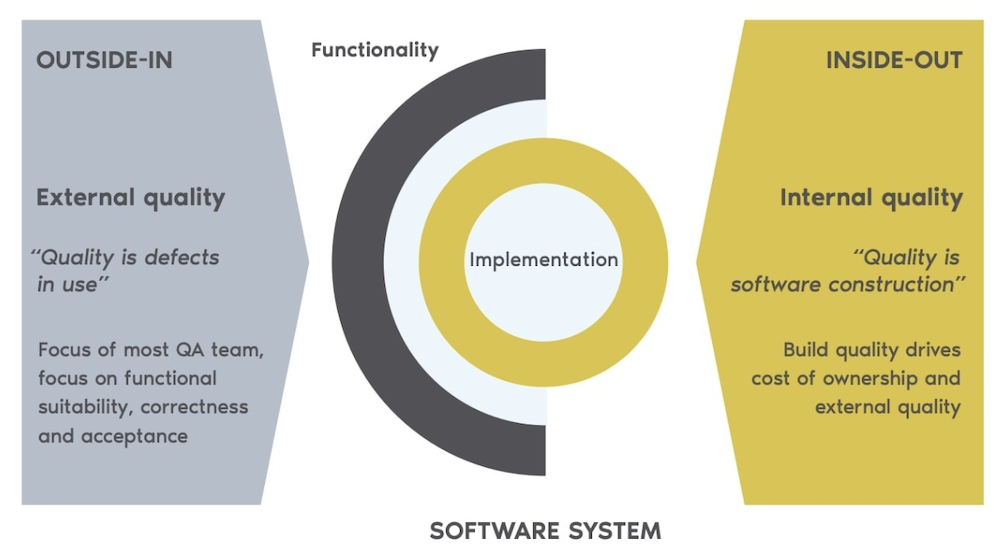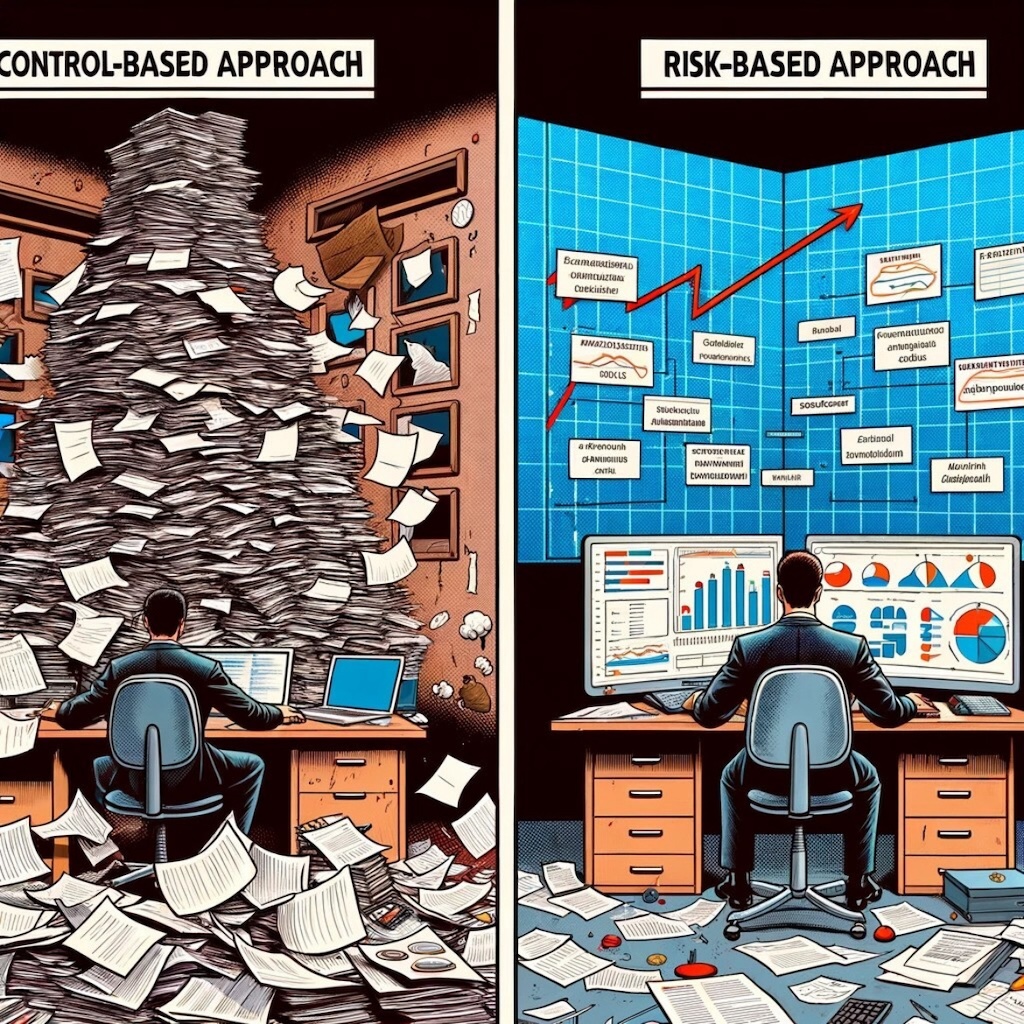The benefits of software quality management
In this article
It should come as no surprise that organizations depend on software to operate. If you look beneath the surface of any organization, you’ll likely find a vast array of source code that keeps operations running smoothly.
Generally speaking, developers want to create maintainable systems by writing high-quality code and organizations want to have good systems.
So, that sounds pretty clear, right? Development teams within the organization and leadership all work toward the same goals and alignment is never an issue.
Well, while we certainly wish this was the case, the reality is unfortunately a little bit different.
Fulfilling crucial commercial demands and meeting tight deadlines often comes at the expense of software build quality.
What happens if software is of lower build quality?
Even while software systems may seem to work just fine on the surface, hidden issues in the source code can cause far more harm than expected.
From code that’s a nightmare to maintain to vulnerabilities opening the door to severe security breaches; neglecting the quality of your software can expose your business to serious risks—including financial losses, operational disruption, and reputational damage.
On the other hand, having high-quality software systems will reduce software TCO, improve your security, increase productivity, and increase your ROI.
Naturally, this other side sounds a lot more appealing, but how do you get there?
This is where software quality management (SQM) comes into play.
SQM not only mitigates risks but also reduces costs, ensures compliance, and allows businesses to focus resources on innovation and growth—offering a range of long-term benefits.
But we’re not saying it’s easy.
However, like with everything else, it starts with awareness. So, to help, we’ve written this article which outlines the key advantages your organization can leverage by adopting SQM.
Before we dive into the benefits of Software Quality Management, it’s worth taking a moment to quickly explain what SQM entails quickly.
Software Quality Management definition
At its core, Software Quality Management (SQM) ensures software quality is embedded throughout the software development lifecycle (SDLC), whether it’s developed in-house or sourced externally.
Your software systems should function as expected, satisfy users, comply with industry standards, and align with business objectives. Equally important—and often overlooked—your systems should be easy to maintain, secure, flexible, scalable, and future-proof.

In our latest Benchmark report, we highlighted that to fully understand the risks of a software system, it is not enough to look at the software from the outside. You really need to look at all the code, only then a full understanding is possible.
Did you know that seeing a demo, using the software, or trying to break in from the outside will show less than 10% of the potential trouble?
In its essence, SQM can help ensure your software is developed and maintained to meet both its functional and non-functional requirements. But it has more to offer, let’s look at six benefits you can gain from implementing SQM in your software development life cycle.
The 7 key benefits of Software Quality Management (SQM)
1) Improved software-related risk management
Software Quality Management helps detect and mitigate functional defects and security vulnerabilities early, tackling risks at the root before they become problematic.
A recent example comes from a bug in a CrowdStrike software update, which led to a global IT outage impacting services from aviation to banking, and healthcare.
But this is just one of the most recent examples. In 1999, an software flaw in the IT system of the UK Post Office incorrectly showed that money had gone missing, leading to the wrongful conviction of hundreds of employees. Spotting faulty code early in the development process can save your organization significant costs and reputational damage.
Beyond functional flaws, software risks can also pose serious cybersecurity threats. Notable incidents include the Adobe breach of 2013 and large-scale data breaches at Yahoo, Marriott International, Facebook, LinkedIn, and Twitter resulting in the exposure of billions of users’ data.

These incidents underscore the importance of proactively addressing security risks within your software to prevent serious consequences.
In fact, in 2022, we discovered a direct relationship between poor software quality and increased security vulnerabilities. In short, SQM helps secure your business, employees, customers, and clients from avoidable dangers.
2) Lower maintenance costs
Did you know that the cost to identify and fix an error grows exponentially as time goes on in the SDLC?
Nearly half of IT budgets are spent correcting software bugs and errors. With SQM, many of these issues can be caught early—before they launch.

SQM can significantly cuts costs and reduce software TCO by helping you to identify and resolve issues early, helping you avoid unnecessary resource allocation later.
3) Reducing technical debt
Did you know that around 41% of enterprise IT budgets are currently being spent on managing the ‘technical debt’ incurred by flawed software and code?
Just as it’s difficult to cook in a cluttered kitchen, adapting and developing software in a messy codebase will inevitably impact its quality. This ‘mess’ is what’s known as ‘technical debt.’ In 2022 alone, technical debt cost US businesses an estimated $1.52 trillion.
Cor van Herk, IT director at Keylane spoke about it during our IT leadership event SCOPE 2024, and even shared the steps his organization took to manage it.
By embracing SQM, you can create a clean, well-documented codebase that’s easier to maintain, update, and scale throughout its lifecycle. This proactive approach will help reduce your technical debt over time.
4) Improved time-to-market and team productivity
Productivity may not be a headline-worthy buzzword, but it is critical.
According to Raymond Kok, CEO of Mendix, “Productivity means people aren’t bogged down by repetitive tasks”.
During SCOPE 2024, Raymond spoke about how productivity is all about people and creating game-changing opportunities.
When developing software in-house, Software Quality Management (SQM) is equally beneficial for improving time management.
With SQM, development teams are free from fixing bugs and ensuring systems stay operational. You can spend more resources on innovation, adding new features, and launching systems faster than before.
High-quality software can accelerate time-to-market by up to four times.
5) Ensure compliance
Many industries have strict regulatory requirements for data protection, privacy, and security. Non-compliance can be extremely costly—just look at the $1.2 billion fine imposed on Facebook’s parent company, Meta, for breaching GDPR regulations.
By adhering to SQM practices, your software will comply with current and future standards, ensuring regulatory alignment across all regions.
For instance, TBA Group, a leader in port solutions and logistics software, achieved ISO/IEC 27001 certification using software quality assurance platform, Sigrid®.
6) Efficiently manage your open source software libraries
It is no secret that businesses are increasingly reliant on Open Source Software (OSS) libraries. According to CISQ, 77% of organizations reported an increase in the use of open-source software in 2021, and for good reason—(OSS) is free to use, ready to implement at any time, and does not require you to spend time and money developing your own software.
However, using open-source, third-party, and commercial components also introduces supply chain vulnerabilities. Business technology leaders agree: 82% of CIOs believe their software supply chains are exposed to threats. When you dwell on that figure for a moment, it’s clear how widespread the problem is.
Did you know that last year alone, nearly 29,000 security vulnerabilities were identified in open-source packages?
This statistic isn’t just alarming—it’s growing.
In one of our recent Ask-me-anything sessions, Jan Laan, one of our senior consultants and security experts, explained exactly why it’s essential for your organization to understand open-source vulnerabilities and take measures to mitigate risks.
Next to the security side of open source libraries, there are also significant licensing and legal risks attached that need to be managed.
7) Building software for the long run
Some software created today will still be in use decades from now, just as many systems you use today were developed years ago.
During his inspiring keynote, “The state of software Quality” at SCOPE2024, our CEO Luc Brandts highlighted the importance of building software for the long term.
Enhancing Software Quality Management (SQM) with a software portfolio scan
Implementing Software Quality Management (SQM) is essential for organizations aiming to reduce technical debt, lower maintenance costs, and improve overall software performance.
A Software Portfolio Scan provides a comprehensive analysis of your software portfolio, identifying inefficiencies and hidden risks. By leveraging this service, businesses can gain actionable insights to enhance software quality, ensuring systems are maintainable, secure, and aligned with strategic objectives.
Organizations that implement proper SQM practices can experience up to a 30% increase in development capacity and 2 times more secure systems through the insights provided by services like the Software Portfolio Scan.
Don’t try to do everything at once
You won’t have time to address every bug or flaw in your software. That’s why prioritizing is key.

With our Sigrid® platform, you gain complete control over your software portfolio with actionable insights that prioritize the most critical risks and opportunities for your business.




